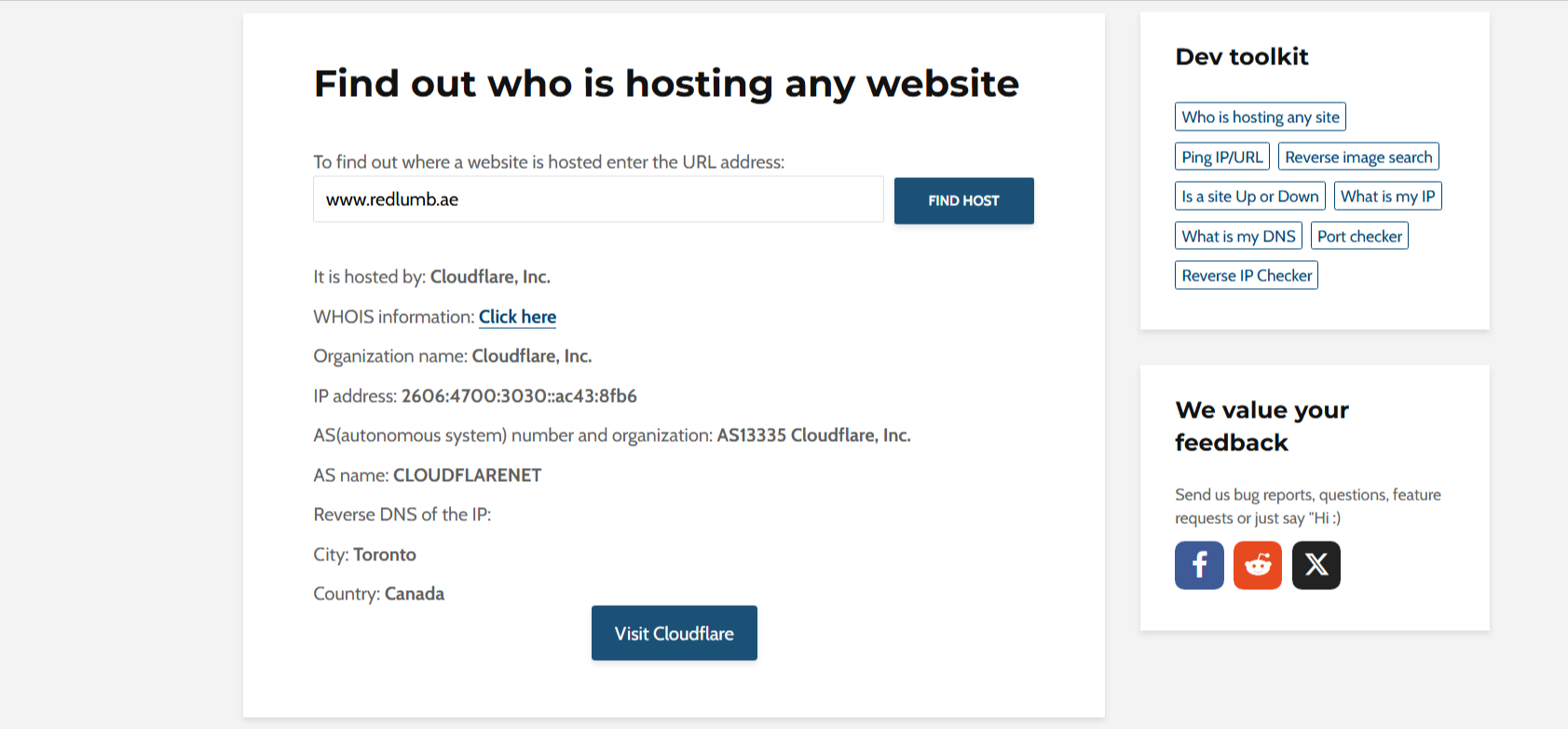Knowing how to check the hosting of a website is crucial for website owners, developers, and digital marketers. Understanding where a domain is hosted can provide valuable insights into a site’s performance, security, and overall management. This knowledge becomes essential when troubleshooting issues, assessing competitors, or simply satisfying curiosity about a website’s infrastructure.
[su_list class=”story-highlight”]Key Takeaways
- Knowing where a website is hosted helps in assessing its performance, security, and troubleshooting, offering valuable insights for web management, competitive analysis, and optimization.
- Methods like the ICANN Lookup Tool, online hosting checkers, and command-line techniques (e.g., ping and traceroute) provide accessible and detailed information about a site’s hosting environment, including server and DNS details.
- Familiarizing oneself with key hosting terms and using multiple tools can improve the accuracy of hosting checks, especially for sites with complex infrastructures, such as those utilizing CDNs or proxies.[/su_list]
How To Check Website Hosting
Before diving into the process of checking the hosting of a website, it’s crucial to gather the necessary information and understand key hosting terminology. This preparation will ensure a smooth and effective investigation.
Gathering Necessary Information
To begin the process of finding out who hosts a website, one needs to collect some essential details:
- Domain name: This is the website’s address, such as example.com.
- URL: The specific web page address you want to check.
- IP address: A unique identifier for the website’s server.
Having these pieces of information readily available will streamline the process of checking website hosting. If you don’t have the IP address, don’t worry – many tools can help you find it using just the domain name or URL.
Understanding Hosting Terminology
To effectively check website hosting, it’s important to familiarize yourself with some common terms:
- Web host: A company that provides server space and related services for websites.
- Domain registrar: The organization where a domain name is registered.
- Nameservers: Servers that translate domain names into IP addresses.
- DNS (Domain Name System): The system that connects domain names to their corresponding IP addresses.
- WHOIS: A database containing information about domain registrations.
[su_service title=”Important” icon=”icon: exclamation-triangle” icon_color=”#00ae27″ size=”20″ class=”ImportntBox”]Understanding these terms will help you interpret the information you find during your hosting investigation. It’s also beneficial to know about different types of hosting, such as shared hosting, VPS (Virtual Private Server), and dedicated hosting, as this knowledge can provide insights into a website’s performance and capabilities.[/su_service]
Method 1: ICANN Lookup Tool
The ICANN Lookup Tool is a powerful resource for those seeking to check the hosting of a website. This free public service allows users to access publicly available information related to domain names and internet resources.
Accessing ICANN Lookup
To begin the process of finding out who hosts a website, one should visit the ICANN Lookup Tool’s website. This user-friendly platform serves as a digital magnifying glass, enabling individuals to investigate domain names and separate genuine ones from potentially deceitful ones.
[su_service title=”Info” icon=”icon: info-circle” icon_color=”#000″ size=”20″ class=”InfoBox”]The tool utilizes the Registration Data Access Protocol (RDAP), which enhances security and provides data in a standardized, easy-to-understand format.[/su_service]

Entering Domain Information
Once on the ICANN Lookup Tool website, users can simply enter the domain name they wish to investigate into the search box. After inputting the domain, they should click the ‘lookup’ button or press enter to initiate the search. The tool will then query the relevant databases and retrieve the available information.
Interpreting Registrar Data
Within moments, the tool will display a wealth of information about the domain. This data includes the domain’s current status, creation date, update date, and registrar information. Users should carefully examine this information, as it can provide valuable insights into the website’s hosting situation.
The ownership details reveal who owns the domain, while the update and expiration dates offer a glimpse into its lifecycle. The registrar’s information is particularly crucial, as it indicates the company through which the domain is registered. This information can often lead to discovering the hosting provider, as many website owners choose to keep their domain registration and hosting services with the same company.
[su_service title=”Important” icon=”icon: exclamation-triangle” icon_color=”#00ae27″ size=”20″ class=”ImportntBox”]It’s important to note that due to applicable laws and ICANN policies, not all domain registration data may be visible in response to a lookup request. Some information may be accessible only to those who have demonstrated a legitimate purpose for viewing it and have been approved to do so[/su_service]
Method 2: Online Hosting Checker Services
Online hosting checker services are valuable tools for finding out who hosts a website. These services provide a quick and easy way to uncover crucial information about a site’s hosting environment.
By entering a domain name or URL, users can access details about the web hosting company, IP address, and other essential data. These tools work by scanning various technical aspects of a website, such as its IP address, DNS records, and WHOIS information, to reveal the company responsible for managing the server hosting the site.
Step-By-Step Guide
To use an online hosting checker service, follow these steps:
- Choose a reliable hosting checker tool from reputable providers.
- Enter the domain name or URL of the website you want to investigate.
- Click the “Find Host” or “Check” button to initiate the search.
- Wait for the tool to process the information and generate results.
Analyzing The Results
Once the hosting checker completes its analysis, it will display a wealth of information about the website’s hosting infrastructure. This may include:
- The name of the web hosting company.
- Server location and IP address.
- Domain registrar details.
- Nameserver information.
- Email service providers.

When interpreting the results, keep in mind that the accuracy of hosting checkers can vary, especially for websites using complex setups like CDNs or proxies. In such cases, the tool might report incomplete or outdated information. To increase accuracy, it’s often helpful to use multiple hosting checker services and cross-reference the results.
Method 3: Technical Approaches
For those seeking a more hands-on approach to checking website hosting, technical methods can provide detailed insights. These approaches involve using command-line tools, examining website headers, and analyzing DNS records.
Using Command Line Tools (ping, traceroute)
Command-line tools like ping and traceroute are powerful utilities for investigating website hosting. Ping helps determine if a website is reachable and measures response time.
To use it, open a command prompt and type “ping example.com”. Traceroute, on the other hand, maps the path data takes from your computer to the website’s server. Enter “tracert example.com” in the command prompt to run a traceroute test.
Examining Website Headers
Website headers contain valuable information about the hosting environment. To check headers, use online tools or browser developer tools. These headers reveal details such as the web server software, caching mechanisms, and security protocols in place. This information can help identify the hosting provider and assess site performance.
Analyzing DNS Records
DNS records are crucial for understanding a website’s hosting setup. Tools like nslookup or online DNS lookup services can help retrieve these records. Pay attention to A records (IPv4 addresses), AAAA records (IPv6 addresses), and NS records (nameservers). These records can provide clues about the hosting provider and the website’s infrastructure.
By employing these technical approaches, you can gain a deeper understanding of a website’s hosting environment and potentially uncover valuable information about its performance and security measures.
Final Words
The ability to check a website’s hosting has a significant impact on various aspects of web management and analysis. By using tools like the ICANN Lookup Tool, online hosting checkers, and technical approaches, website owners and digital professionals can gain valuable insights into a site’s infrastructure and performance. This knowledge is crucial to troubleshoot issues, assess competitors, and make informed decisions about website management and optimization.
Understanding how to find out who hosts a website opens up new possibilities to improve online presence and security. Whether you’re a curious user or a seasoned professional, these methods provide a comprehensive toolkit to analyze and understand the digital landscape. As the internet continues to evolve, staying informed about website hosting remains an essential skill in the ever-changing world of web technology.
Syed Haris Ali is a renowned web developer and designer at REDLUMB, specializing in front-end technologies, with a particular focus on WordPress. Holding a BS in Computer Science, he has successfully delivered over 50 websites across various sectors, providing tailored solutions to meet diverse client needs. With a keen eye for design and a passion for functionality, Haris creates engaging user experiences that elevate brands online.




![How to Make Your Website Show Up on Google [All Steps]](https://redlumb.ae/wp-content/uploads/2024/11/REDLUMB-Template-6-680x456.jpg)
